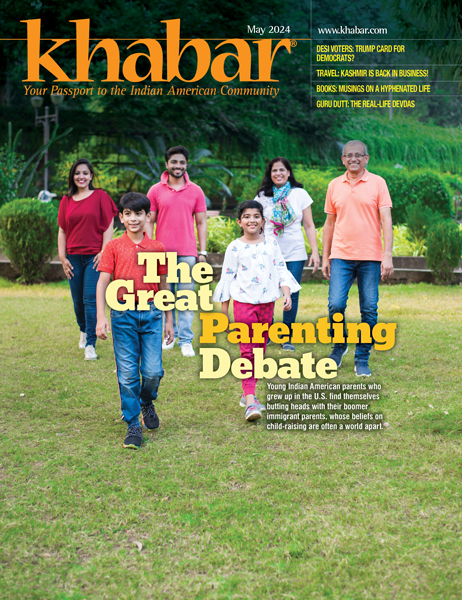Musings: Princesses, Monsters, and Others
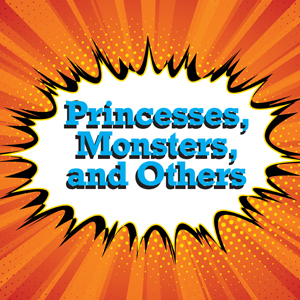
Reflecting on her life as an introverted child in India, NANDITA GODBOLE writes about Indian and Western comic books, which brought unforgettable characters in vivid colors into her home and told stories that provided a blissful escape to imaginary lands.
Children remember the oddest small things, especially moments that bring them joy. I still remember the slick feel of my brand-new, yellow hardbound copy of Noddy and His Car, which I held tight in both hands after winning it in second grade. I remember the comfort of caressing an oversized storybook, Lion & The Dog—with a handsome lion on the cover and ochre-colored pages—and marveling at a rooster’s flamboyant tail in The Cock with the Crimson Comb. I recall the narrow foyer to a building in the commercial district of Dadar TT, literally filled to the rafters with magazines and comic books, and the annoyed glances of a lean shopkeeper who guarded his wares from curious children like me. I would eye the comics wistfully as we waited for the Number 64 bus to take us home. Most of all, I remember the triumphant moment I walked over confidently to purchase my first Amar Chitra Katha, whose dramatic depiction of a shipwrecked princess (Ratnavali) had captivated me for weeks. That copy was mine now.
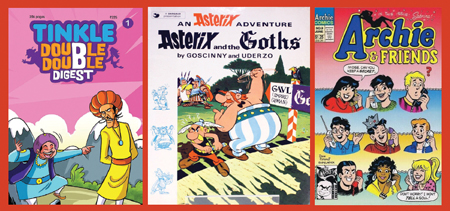
But it wasn’t just the love of these characters or stories that held my attention. With my father’s lifelong commitment to Mumbai Police, we moved from one government apartment to another once every few years. Most often, my playthings would conveniently get “lost” on the mover’s truck—and this being the time before telephones were common, childhood friendships would get lost as well. That’s when comic books came in handy. While I couldn’t control our frequent moves across the city, I found reassurance in the places where my favorite characters lived: Noddyland, and the no-name forests and landscapes of comic books.
Not only were comic books my escape from unfamiliar spaces in the real world, but they were often helpful in making new friends.
A library membership was expensive back then. Within a few weeks of moving, my brother would have determined who had the best selection of comics in our apartment block. As a boy who was a few years older, he had more leeway in wandering unchaperoned, and he was also better at finding new friends. Their collections offered Phantom, Chandamama, Champak, Tinkle, Little Lulu, Richie Rich, Lotto, and other comics. As we outgrew these, others entered the scene—Tintin and Asterix alongside the staples of Amar Chitra Katha (ACK), which I favored more. With material from the Ramayana, Mahabharata, Panchatantra, Jataka tales, and even the Akbar-Birbal stories, the ACK comics were cheaper, and also easier to convince my parents to purchase! I spent much of my Diwali money on them.
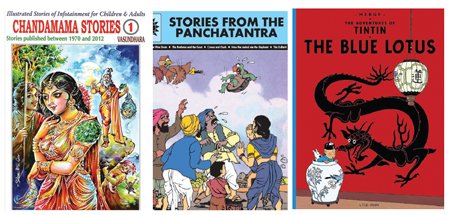
In time I learned that the social currency of comic book exchanges had another unspoken caveat— whether or not someone owned imports like Tintin, Asterix, Archie, and Madd digests. Of these, Asterix and Tintin were large, full-color comics on thick glossy paper. The English was different, with funnysounding slang words and comical themes focusing on lovable characters, like the frequently drunk but helpful Captain Haddock, the funny druid Getafix, or the unwavering friendship of Asterix and Obleix. The whodunit themes of Tintin with little Snowy felt familiar in my household, although none of our dogs were named Snowy. But these large and glossy comic
books, often owned only by affluent children, remained a status symbol. Another aspect: Not surprisingly, Archie and Madd were traded more gleefully among boys than girls, who were often mortified by their raunchy humor because it inspired unwanted advances.
Decades later, by the time I had a child of my own, ACK was selling their books as bound sets. I started our young one with her own collection, particularly by buying a few copies each Diwali. Although during the year her bookshelf would overflow with titles like Maisy, Angelina Ballerina, Olivia, or Tintin, Amar Chitra Katha took precedence between Navratri and Diwali. Each night we would read one after another, until she drifted off to sleep. They encouraged questions and curiosity, encouraged cuddling together to see the pictures and laugh together.
Something special emerged in those evenings of simple bed-time stories with my daughter. They were not only about the cultural anchoring I was hoping to inspire. I began to finally understand why I used to love them so much. More than words, each frame richly captured context and details. The gentle arch of a heroine’s back as she leaned into a tree when she gathered with friends, or the curled fingers of a protagonist when he was angry. Even though I wanted to race ahead and see how each story ended, I would scan the expressions of the characters, lingering on every frame to read between the lines and wonder what they were thinking.
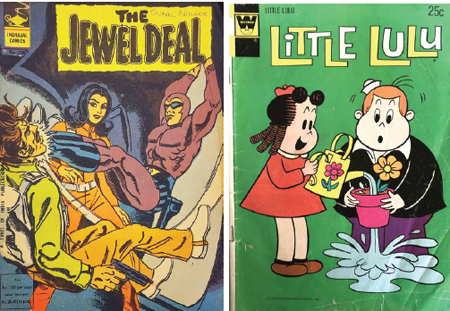 My daughter shared my curiosity—and interest. Like me, some of her birthday money was spent on comic books at the bookstore. On each trip to India, she would seek out Tintin titles to complete her collection. She managed to find all but the banned Tintin in Congo. Together we would laugh at the antics of the characters, marvel at the art, at the elegance, and how simple strokes of a pen could tell a story, leisurely, consuming each frame. It reminded me of the beloved R. K. Laxman’s cartoon of the common man, the very first thing I would read when I picked up The Times of India as a child. Our shared love of animated stories only grew to embrace tales from many cultures. My art-loving daughter’s friends would introduce her to other fantastic beasts, and she would prod me to find those new titles.
My daughter shared my curiosity—and interest. Like me, some of her birthday money was spent on comic books at the bookstore. On each trip to India, she would seek out Tintin titles to complete her collection. She managed to find all but the banned Tintin in Congo. Together we would laugh at the antics of the characters, marvel at the art, at the elegance, and how simple strokes of a pen could tell a story, leisurely, consuming each frame. It reminded me of the beloved R. K. Laxman’s cartoon of the common man, the very first thing I would read when I picked up The Times of India as a child. Our shared love of animated stories only grew to embrace tales from many cultures. My art-loving daughter’s friends would introduce her to other fantastic beasts, and she would prod me to find those new titles.
As an empty nester now, I often wander into our daughter’s room and dust the spines of her still-pristine Tintin and ACK collections. They take up space in our home, but they are more important to have in our lives. Childhood is nothing more than dates on a calendar. I am reminded of the innocence and simplicity in those stories meant for children. They can teach that stereotypes of form and depiction only matter if we let them. Isn’t every parable, every story, and every children’s book a way to strengthen our belief in the goodness of all? I had fallen in love with imaginary worlds where kindness and friendships mattered enough. I am reminded each day that these core virtues transcend time and place and remain as valuable today as they were on the day they were written. Or maybe, I just have a soft spot for character-building cartoon characters, kindhearted spirits who are only looking for acceptance.
Nandita Godbole is an entrepreneur, cookbook author, and speaker in the food and wellness space. Masaleydaar: Classic Indian Spice Blends is her most recent book.
Enjoyed reading Khabar magazine? Subscribe to Khabar and get a full digital copy of this Indian-American community magazine.
blog comments powered by Disqus




